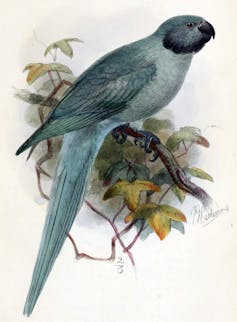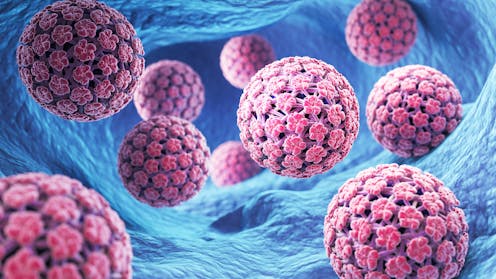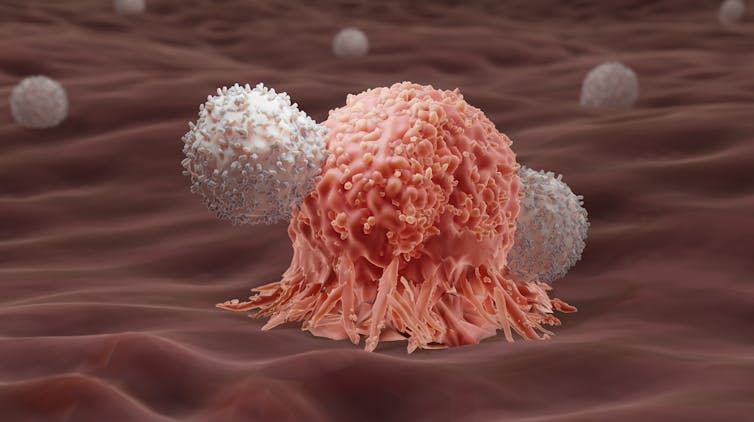Source: The Conversation – UK – By Jack Ashby, Assistant Director of the University Museum of Zoology, Cambridge, University of Cambridge
One day in August, 1875, a greyish-blue parrot was shot on a small island in the Indian Ocean near Mauritius. It was the last time a Rodrigues parakeet was known to be seen alive.
That bird was one of only two ever preserved. Exactly 150 years on, both rest under our care at the University Museum of Zoology in Cambridge, England. Aside from a few fossilised fragments, they represent the only physical evidence the species ever existed.
For many extinct animals, museums are now their last remaining habitat. Without these collections, we wouldn’t just have lost the creatures themselves – we’d have lost the very knowledge that they existed at all. This can be thought of as double extinction.
As I explore in my recent book, Nature’s Memory: Behind the Scenes at the World’s Natural History Museums, those of us working in museums take seriously the responsibility of safeguarding the proof of what species we have shared our planet with, and how that diversity has changed over time. Our collections are constantly being used to learn lessons from past losses and this role has only ever increased over time.

University Museum of Zoology, Cambridge
Extinction and sex bias
There are a few enigmatic accounts of green and blue parrots by sailors marooned on Rodrigues in the 1700s, but a specimen wasn’t collected until 1871. That was when the British colonial administrator on Mauritius, Edward Newton, received a female bird that had never before been scientifically described. (Scientists must write a formal “description” of a new species for it to be officially recognised).
Newton sent the preserved parakeet on to his brother Alfred Newton – 19th century Britain’s most eminent ornithologist and the University of Cambridge’s first professor of zoology – who described the new species in print.

zelvan / shutterstock
This makes it something of a rarity: only a quarter of bird species are described using female specimens, meaning that in most cases the male form is effectively considered the standard representation of its species, while the female is considered the “other”.
Incidentally, although women have always played a major role in natural history, only 8% of birds named after people are named after women. This is one of the reasons why I refer to this species as “Rodrigues parakeet”, named after its home island, in preference over its other name, Newton’s parakeet (though ironically in this specific case the island also happens to be named after a man).
In a further display of the human social gender biases underlying much of natural history, having been offered the opportunity to publish an illustration of the specimen alongside his description, Alfred Newton wrote that “as it is unluckily that of a female bird, I refrain from giving one”. He was holding out for a male.

John Gerrard Keulemans / wiki, CC BY-SA
Due mainly to deforestation for agriculture on Rodrigues, over the course of a century, the once common parakeet’s population had crashed. When further searches for the bird were unsuccessful, Newton eventually provided an illustration of the species – still based on that lone female.
That same year, when one was shot on August 14, 1875, Edward Newton was finally able to send his brother the male he desired. None was ever seen again, and it is quite possible that it was the true endling: the last living member of its species.
Precious little remains
Many extinction tales, and indeed the natural history museums that tell them, are intertwined with colonialism. Dodos, from nearby Mauritius, became the ultimate icons of extinction partly because they are relatively common in museums worldwide.

The Art of Pics / shutterstock
Edward Newton again played a role: he was the islands’s colonial official in 1865 – almost 200 years after the dodo’s extinction – when Indian indentured labourers were ordered to extract hundreds of dodo bones from a Mauritian swamp, feeling for them in the mud with their bare feet. This is the origin of almost all dodo bones in museums today.
However, countless other lost species, like the Rodrigues parakeet, are represented only by one or two specimens. Without museums preserving these precious remains, we could never comprehend what has been lost. Beyond scientific research, these specimens provide museum visitors with a tangible connection to the permanent reality of extinction.
Found, lost, described
This isn’t just a 19th century story. In 2000, for instance, a single snake-eyed lizard was collected during fieldwork on a wooded plateau in northwest India. It was preserved in the vast collections of the Bombay Natural History Society, before being described as a new species 20 years later: Ophisops agarwali.
But when researchers returned to its habitat, they could not find the lizard again. They have concluded that it is probably extinct, most likely because of traditional forest burning practices.
The lizard was caught just in time to be recognised – but not in time to be saved.
Why these losses matter now
Like the lizard, the Rodrigues parakeet’s story isn’t just a quirk of natural history – it’s a warning. Across the world, species are being lost far faster than we can name them. It’s a sad truth that there are undescribed species in museum storerooms which can no longer be found in their wild habitats. Some become extinct in the window between collection and description.
When we preserve those fragments, we keep more than a specimen. We keep a record of what the planet once held.
If that single lizard had not been caught in 2000, or if those parakeets had not been stored in 1875, the existence of their species would never have been recognised and nor would its loss. We are both richer and poorer for that knowledge.
![]()
Jack Ashby is affiliated with the Natural Sciences Collections Association.
– ref. The Rodrigues parakeet’s last day: what one extinct bird tells us about the role of museums – https://theconversation.com/the-rodrigues-parakeets-last-day-what-one-extinct-bird-tells-us-about-the-role-of-museums-263086











